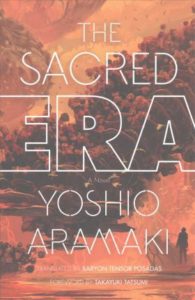In Yoshio Aramaki’s The Sacred Era we are presented with a common trope of a young male hero who is part of a quasi-theocratic, interstellar empire. In order to fulfill his destiny, he must challenge both the existing political order and the sense of ethics it has provided. In the broad strokes, it resembles Frank Herbert’s Dune series or Isaac Asimov’s Foundation series. These similarities are not surprising since this original Japanese work was published in 1977. But a genre writer following a trope does not inherently make derivative work. Like Aramaki, they have the opportunity to use the structure to explore finer permutations of their topics.
Aramaki threads his narrative through questions about the nature of existence and faith. The novel’s protagonist, the evocatively named K, is a young prodigy from the countryside of a dying world. His aptitude for religious studies has made him an attractive prospect for the theocratic order. But like all potential candidates who would like to enter the upper echelons of society, he must undergo a series of tests. But unlike so many who find themselves caught in the Hero’s Journey, K’s first tests are literal exams. His travel to the capital city to take these bankrupts him, and he must stay in a colony of indigent people. One mysterious, beautiful woman breastfeeds him each night of the exam so he can have the energy for the next day.
Like Luke Skywalker or Paul Atreides, K excels and is soon on track to show his leadership, while unwinding his destiny. The particular path the Papal Court of the Holy Empire of Igitur sends K down is to locate Bosch, a rogue planet that used to orbit Earth, possibly inspiring Hieronymus Bosch to create The Garden of Earthly Delights. The quest leads him across the physical and metaphysical universe. In the end, he discovers only a beginning.
The aesthetic bent to the narrative resonates with a type of science fiction that pushes past the hero’s cycle. Much like Arkady and Boris Strugatsky’s Roadside Picnic (which was adapted for screen in Tarkovsky’s Stalker), this novel is attentive to the truly alien and ineffable qualities of the events the characters encounter. K as representative of the Papal Court, experiences events that are not exactly spiritual but supernatural in that their functioning is not fully comprehensible to humans. Yet the reader is provided with enough provocative details to be drawn into worlds that move from the uncanny to the unfathomable. Technobable is set aside for an approach that draws the worlds into the realm of fantasy. This is fitting since it perhaps provides an understanding of how a decadent but overly-religious technologically advanced society would approach science that conflicts with its world view.
Aramaki’s narrative is familiar. But the nuance of his details, of his world construction, seem more prescient than it actually is. But a theocratic oligarchy lording over an environmentally devastated planet feels increasingly relevant each time I turn on the news. I understand that Aramaki was writing in response to his own time but the seeming timeliness reveals both the author’s perspicacity and insight. As importantly, the reader is given a compelling (if familiar) narrative to follow in order to experience these qualities.
The Sacred Era
Yoshio Aramaki
University of Minnesota
ISBN: 978-0816699865

 By
By 







